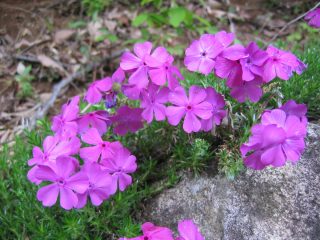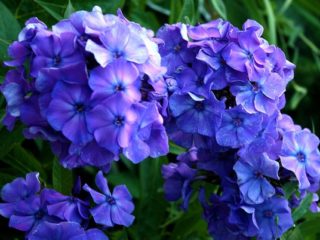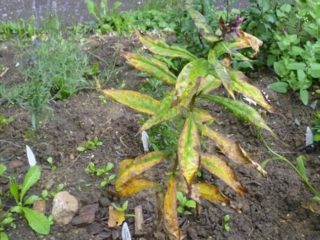Content
Phlox Sherbet Blend is a plant with a unique color of flowers. Because of this, it is often confused with hydrangea. For normal growth and flowering, the culture requires regular care, which consists in timely watering and feeding. But the effort is worth it, because of the whole variety of phlox, the Sherbet Blend variety is one of the most decorative. Moreover, it has a wonderful aroma.
Description of panicle phlox Sherbet Blend
The stems of the phlox Sherbet Blend are 100 to 120 cm long. They have a round cross-section and are strong enough to support the weight of heavy inflorescences without additional support. The bush is moderately spreading, reaching 120 cm in diameter.
Phlox leaves Sherbet Bland have a standard shape for the species: they are pointed at the end, their dimensions are 80-100 mm in length and 20 mm in width. The color of the leaves and stems is light green.
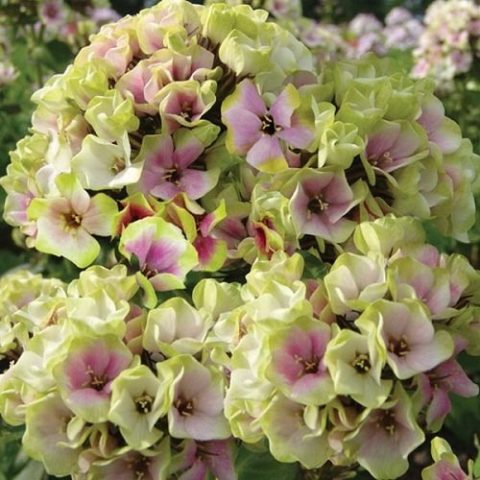
Phlox flowers Sherbet Blend have a complex color: inside they are pink, and outside they are yellowish-green
The culture is light-loving, but it can be grown in partial shade. In the middle of the day, so that too bright sun does not burn the plant, it is recommended to shade it.
Growth rates are high, but when they reach a certain size, they slow down. This is due to the fact that the rhizome practically does not grow after 4-5 years, since the culture lacks nutrients, and its division is required.
The frost resistance of phlox Sherbet Blend corresponds to the fourth zone, that is, the plant can withstand temperatures up to -35 ° C. It is cultivated in the European part of Russia up to the Urals.
Features of flowering phlox Sherbet Blend
Phlox Sherbet Bland is a typical representative of the European group. The flowers can be up to 50 mm in diameter, but they usually never fully unfold. The petals are wavy, at the beginning of the blooming of the bud they are painted in a yellowish color, but as it opens, the center changes color to pink.
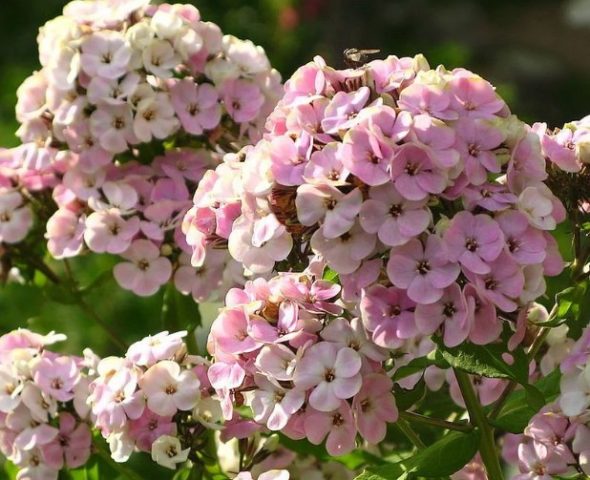
Phlox inflorescences Sherbet Blend are large and dense, up to 20-25 cm in diameter
It blooms for a very long time, from July to September. This has a simple explanation - the buds of the plant bloom unevenly. At the same time, the occupancy of the paniculate brush is quite dense, and there are no falling out fragments in it, that is, the decorative effect of the bush does not suffer.
In open areas, the intensity of flowering is higher, but the petals dry out faster, which leads to a reduction in its duration by about a month. In shaded areas, the size of panicles is slightly smaller (no more than 18 cm), but the density of individual components remains the same as in illuminated areas. The duration of flowering in partial shade is also shorter due to the fact that some buds do not even have time to open.
In addition to illumination, the duration and intensity of flowering is affected by soil fertility and applied fertilizers, which is typical for all representatives of phlox.
Application in design
Like all similar tall semi-spreading bushes, phlox Sherbet Blend is widely used in the design of garden and suburban areas. Given its high decorativeness, it is often used in the recently fashionable monosade-floxaria, that is, in planting on several tens of square meters of the same culture.
In addition, the plant is used as the basis of a flower arrangement.You can create scenic areas by planting the Sherbet Bland phlox with other flowers that are in the same range with them (that is, both pink and yellowish green).
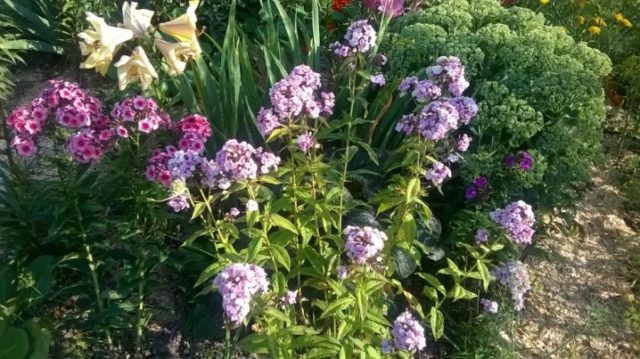
A mixborder with tall lilies and irises can be a good solution for culture.
It is allowed to plant the phlox Sherbet Blend against the background of tall hedges of coniferous plants, use them as medium-sized curbs, as well as use them as free-standing elements in alpine slides and rockeries. They also look good in the center of flower beds with low-growing perennials and perennials.
It is allowed to grow crops in a separate container (not in the open air, in greenhouses and other premises). It should only be remembered that the size of the root system of the phlox Sherbet Blend is quite large, and once every 3-4 years the rhizome will have to be divided by transplanting its parts into a smaller container.
Reproduction methods
Obtaining offspring from this culture completely repeats this process in most garden perennials and can be both vegetative and seed. The latter is rarely used because of the long growing times and unpredictability of characteristics in the offspring, since pollination can be cross-pollinated with other varieties or hybrids.
Most often, they use the traditional reproduction for perennials with large rhizomes by dividing the bush, associated with plant transplantation. Usually, at the age of 3 years or more, the culture needs to update the root system. Growth rates are slowing down, as it cannot cope with the supply of nutrients to the bush.
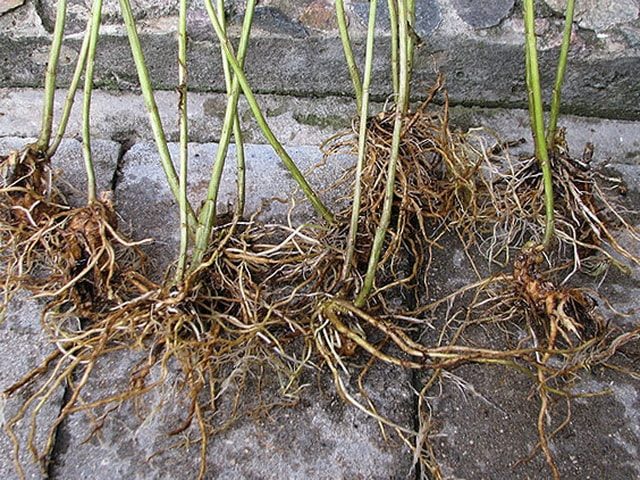
In phlox Sherbet Blend, the rhizome is divided into separate single roots (up to 10 pieces), which are then planted in open ground
It is recommended to select only the strongest roots with a large number of lateral branches. The transplant is carried out to a new place, but this is advisory, not mandatory.
If you need to get a large number of seedlings, a more complex method is used, which consists in cutting stem cuttings. In this case, the stem is divided into fragments up to 20 cm long, having at least three nodes.
Stem cuttings can be planted immediately on their permanent habitat and 9/10 of them will take root perfectly if reproduction was carried out at the beginning of summer.
If you need even more planting material, use leaf cuttings containing 1-2 nodes. But they are grown in greenhouses, and the survival rate rarely exceeds 40%.
Reproduction by layering is also sometimes used, but since it is recommended to cut the stems in the fall, they may not have time to form a root at the point of dusting with earth.
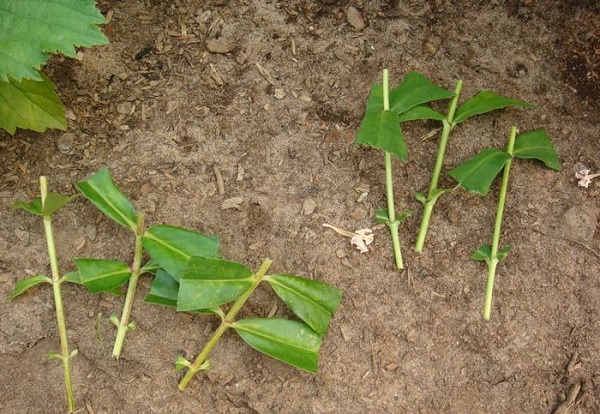
Before planting, stem cuttings can be treated with Kornevin
Landing rules
The optimal time for planting phlox Sherbet Blend is late summer or early autumn. Plants planted at other times (with seeds in spring, and leafy cuttings in early summer) do not take root very well and take too long to develop.
For planting phlox Sherbet Blend, choose a sunny area with the possibility of shading the bush for 1-2 hours at noon. The soil must be loose and fertile. The culture grows well on loams of medium density with weak acidity (pH not lower than 6.5).
Soil preparation is carried out one month before the intended planting. It consists of the following stages:
- clearing the site from weeds;
- fertilization (best of all organic matter - humus, compost or peat);
- adding baking powder to heavy soils;
- repeated digging of the landing site and its alignment;
- watering the prepared area.
Sowing material does not need preparation, cuttings and seedlings can be planted immediately after purchase or receipt.
The depth of the phlox holes Sherbet Blend depends on the size of the root system (for cuttings 5-6 cm). The distance between the landing pits is from half a meter. Watering is carried out 2-3 days after planting.
Follow-up care
Watering the phlox Sherbet Blend is carried out when the top layer of the soil dries up. The plant requires a large amount of moisture for normal growth and development, so watering rates are up to two buckets per square meter. m area.
Loosening at the end of the procedure is necessary, since the phlox Sherbet Blend does not tolerate stagnation of moisture in the soil. This also simplifies the access of air to the roots. Watering is carried out in the evening.
Phlox bushes Sherbet Blend require four dressings:
- In early spring, after the snow melts, a complex nitrogen-phosphorus fertilizer is used for ornamental plants.
- At the end of May (budding period), phosphorus-potassium fertilizers are used for flowers in a minimum concentration.
- At the end of June (the beginning of flowering), a fertilizing similar to the previous one is used, but with a full concentration of fertilizers.
- At the end of September, after flowering and pruning, organic or complex fertilizer is used for flowers.
Pruning the plant is done immediately after it has faded. The stems must be cut, leaving stumps no more than 10 cm in height. After pruning, the soil should be treated with antifungal agents and insect and mite repellent.
Preparing for winter
Phlox Sherbet Blend does not require specific preparation for the winter period, since the stems still die off at the end of autumn, and the root system is able to withstand frosts down to -35 ° C. Nevertheless, it is advisable to carry out some kind of minimal care procedure, but not so much in order to prepare for the cold weather, but to provide the plant with nutrients in early spring.
Usually, for this, the hemp from the cut stems is sprinkled with a bucket of horse manure and covered with some kind of material. To avoid debating the root system in early spring, use "breathing" agrofibre.
Pests and diseases
The greatest danger to phlox Sherbet Blend is represented by fungal diseases in the form of downy mildew and gray rot. Of the pests, the most unpleasant is the rootworm nematode.

Downy mildew symptoms are standard for almost all crops - leaves are covered with white bloom
Bushes growing in excessively humid and poorly ventilated places are usually affected. In sunny areas, cases of the disease are practically not recorded. The fight against the disease is carried out by removing the affected fragments and spraying the plant with any fungicide.
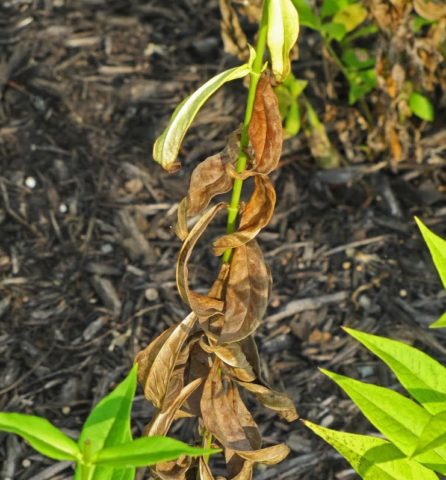
With gray rot, the foliage on the stem wilts.
Initially, light dots appear on the plant, eventually turning into spots. Over time, they grow and merge. There are many black dots on the back of the leaves. The stems, as a rule, are not affected by the disease.
As such, there is no cure, the plant will have to be removed completely. The cultures remaining in the garden are treated with a solution of 1% Bordeaux liquid or with Hom. For the prevention of appearance in the ground, it is recommended to add Fitosporin.
Nematoda is one of the main pests, which is a worm with a long and very thin body; it lives in the stems of the plant and feeds on it.
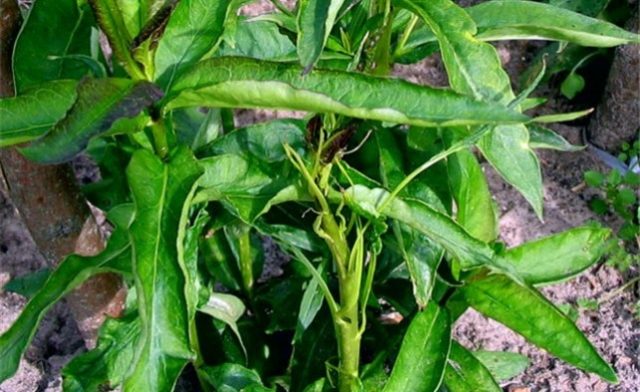
Phlox infested with nematode bends, and their leaves curl
There are no effective methods of pest control. Only prevention remains: in plants with minor damage, the growth point is removed. Bushes with serious lesions are destroyed. In this way, they try to kill adult nematodes so that they cannot give offspring that would infect the culture the next year.
Conclusion
Phlox Sherbet Blend is a beautiful sprawling perennial shrub with decorative flowers of two different shades. Growing it requires concentration and accuracy, since it is necessary to follow the watering and feeding schedule to keep the plant in good shape. In landscape design, phlox Sherbet Blend is used in a wide variety of roles - from an element of a monosad to a central "role" in a flower bed. Curbs and background plantings can be made from it.
